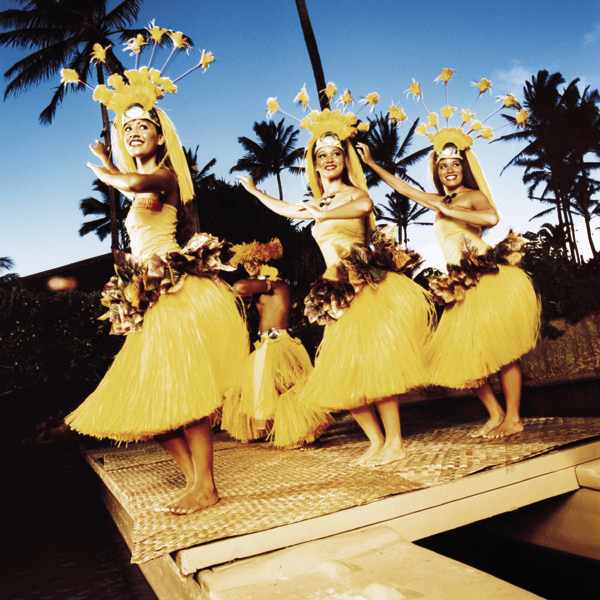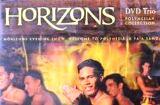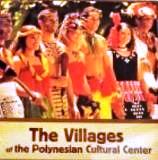
Polynesian Cultural Center Tahitian Dancers dancing in the Pageant of the Long Canoes performed daily at the Center.
While all cultures around the world have their own dances, none seem to be more synonymous with dancing than the cultures of Polynesia, and none more famous than the Tahitian tāmūrē (tah-moo-ray).
Most people in the world will be able to describe Tahitian dancing in one way or another, even if they are not able to identify it by name. The most likely responses received when asking random people about the tāmūrē (asked as “Tahitian dancing”) are “quick rapid drum beats,” “athletic men shaking their knees and jumping,” and, perhaps the most common of all responses, “girls in grass skirts shaking their hips.”
It’s difficult to not be amazed when watching the Tahitian dancers perform. The drum beats grow more and more rapid and yet the dancers appear undaunted as they match the drums beat for beat to a point of seemingly superhuman speed.

Vaimiti Cates in the Polynesian Cultural Center Tahitian Village
The predecessor to the tāmūrē was the ‘upa’upa, and was actually outlawed by English missionaries because of its sexual undertones. Not ones to be completely controlled, the Tahitians would dance in secret.
Many years later when the French took over, they were then allowed to dance during celebrations, but were still restricted in their dancing. As time went on and with tourism starting to become a major industry, Tahitian dancing started to flourish once again. Although modern dances are not the same as their predecessors, they are still just as awe inspiring.
Even now to the outside viewer, the dance may seem overtly sexual, but it is a way of connecting to one’s culture.
Vaimiti Cates, a Tahitian BYU-Hawaii student, explains that Tahitian dance is “a way to have extreme joy and be able to share that joy, but especially the message given by the music or the song danced. In the Tahitian culture, dancing was first a ceremonial thing to express joy, to tell a story, to share a message, and a way of keeping legends. BUT it is especially a way of gathering to have fun and mix with others.”
The predecessor to the tāmūrē was the ‘upa’upa, and was actually outlawed by English missionaries because of its sexual undertones. Not ones to be completely controlled, the Tahitians would dance in secret.
Many years later when the French took over, they were then allowed to dance during celebrations, but were still restricted in their dancing. As time went on and with tourism starting to become a major industry, Tahitian dancing started to flourish once again. Although modern dances are not the same as their predecessors, they are still just as awe inspiring.
Even now to the outside viewer, the dance may seem overtly sexual, but it is a way of connecting to one’s culture.
Vaimiti Cates, a Tahitian BYU-Hawaii student, explains that Tahitian dance is “a way to have extreme joy and be able to share that joy, but especially the message given by the music or the song danced. In the Tahitian culture, dancing was first a ceremonial thing to express joy, to tell a story, to share a message, and a way of keeping legends. BUT it is especially a way of gathering to have fun and mix with others.”
Dancing in any form is a great way to have fun, but next time you feel like cutting loose or sharing a message try the tāmūrē.
If you need a few pointers you should visit the Tahitian village in the Polynesian Cultural Center.
For a practical demostration watch this amazing video of Tahitian dancing.
Horizons Night Show Tahitian Section 2008 Polynesian Cultural Center
Trevor Smith
______________________________________________________
|
Learn more about Tahiti at the |
 See the entire Horizons show |

Enjoy the music of Tahiti and other villages at the
|
____________________________________________
 Author Bio: The path from Perris, California to Laie, Hawaii has taken Trevor from high school to the Marines, where he served as a rifleman for 4 years, marriage to the lovely Melinda Smith and finally to Brigham Young University-Hawaii. Trevor’s major is Business Management-Finance plus a Minor in Accounting with a legal studies emphasis. He currently works as a tutor in the Reading Writing Center on campus and hopes to attend law school on the east coast after graduation. Working as a corporate lawyer in New York would be Trevor’s dream job although he can always write about his adventures in Hawaii for his back up plan.
Author Bio: The path from Perris, California to Laie, Hawaii has taken Trevor from high school to the Marines, where he served as a rifleman for 4 years, marriage to the lovely Melinda Smith and finally to Brigham Young University-Hawaii. Trevor’s major is Business Management-Finance plus a Minor in Accounting with a legal studies emphasis. He currently works as a tutor in the Reading Writing Center on campus and hopes to attend law school on the east coast after graduation. Working as a corporate lawyer in New York would be Trevor’s dream job although he can always write about his adventures in Hawaii for his back up plan.


Hello, working at the PCC is a dream, but how do you get hired as a dancer and what are the requirements? I can’t find any job offers on your site. Thank you for your answer
Thank you for the question, Sarah. The circumstances behind the Polynesian Cultural Center is different than any of the commercial entities on the islands. Because we are a 501(c), and our mission is to both preserve and share the Polynesian Cultural and provide training and support to the students attending the university attached to the Center who come from under-represented communities across the Pacific Rim and beyond, employment is generally reserved for those purposes; especially when hiring for our entertainment and guests service positions. Through these efforts, we provide our island students an opportunity to work for a living wage within the tourism, marketing and business industries with a focus on skill building, leadership and public relations while attending classes. We also provide internships and scholarships in support of our student employees.